MSI X610: Supersizing the Netbook?
by Jarred Walton on October 6, 2009 10:00 PM EST- Posted in
- Laptops
Battery Life Comparison
We run many scenarios for our battery life tests. Since most netbooks don't include optical drives, we previously ripped our standard test DVD to a hard drive and copied those files over. Ultimately, performance was similar to what we found with playing back HD DivX files, so we have instead chosen to focus on DivX HD, x264 HD, Internet, and idle battery life.
Video playback is one area where the HD 4330 is definitely a nice bonus, since it has no difficulty accelerating decoding on x264 and other codecs. Then again, the HD 3200 provides similar functionality and consumes less power; battery life likely would have been improved quite a bit by using an integrated solution instead of the 4330. What's truly ironic is that the X610 chipset actually includes integrated graphics, but they are disabled. An option to switch between integrated/discrete graphics in order to improve battery life would have been great.
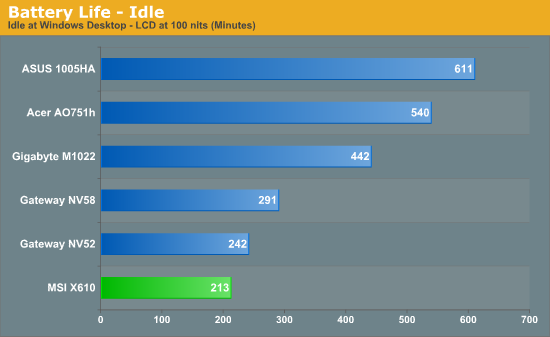
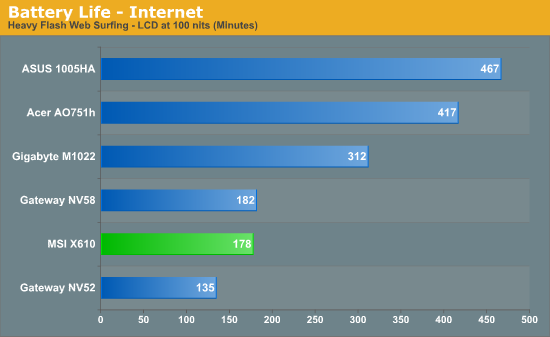
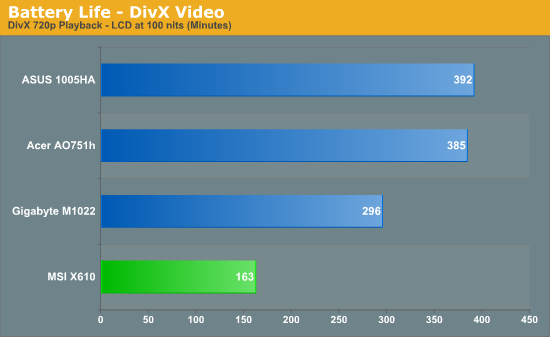
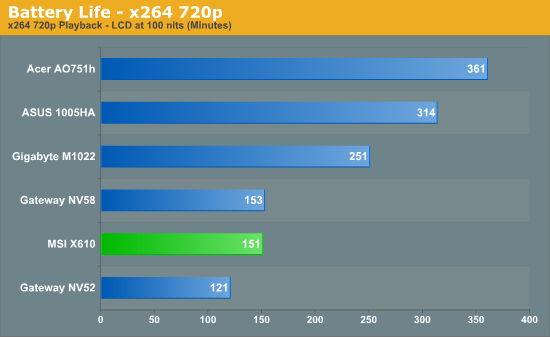
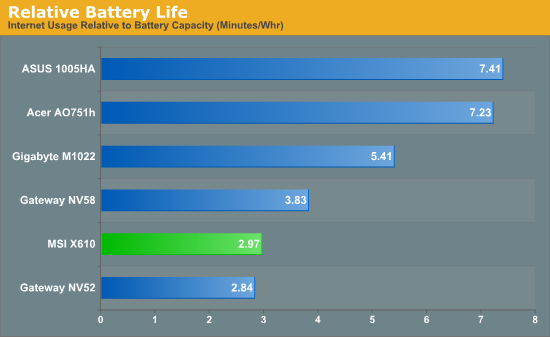
Battery life on the X610 is another mixed bag. Despite having a dramatically slower CPU compared to the NV52 and NV58 along with a slightly higher capacity battery, it only matches the NV58 in Internet and x264 playback. It does manage to beat the NV52 (except in idle battery life where the HD 4330 consumes more power than an IGP), but realistically we're still talking about 2.5 to 3 hours of battery life in most cases. Remember at the beginning where we discussed how the X610 is part MacBook Air? Sadly, one part of the MacBook Air where MSI completely missed the boat is battery life. When you consider that you can get a Core 2 Duo processor in the MacBook Air that substantially faster than the MV-40, battery life and general performance definitely aren't reasons to get the MSI X610.
Power Requirements
As a corollary to the battery life tests, we also performed measurements of power requirements using the AC adapters and a Kill-A-Watt device. These numbers are only accurate to the nearest Watt, so a difference of 1W (i.e. from rounding) could obscure up to a 12% actual difference in power requirements. Also note that power requirements change when you switch to DC power, and power supply (power brick) efficiency comes into play when using the AC adapter, so the battery life tests are a better indication of true power requirements.
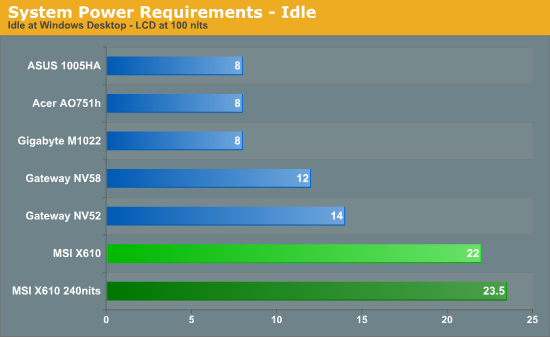
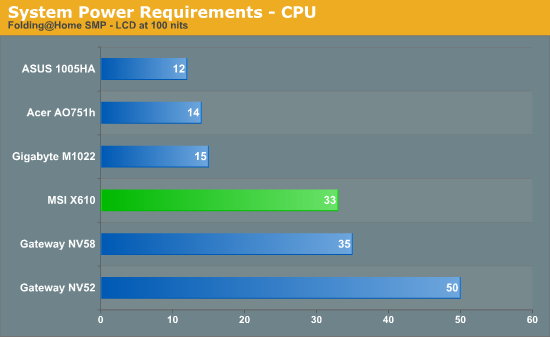
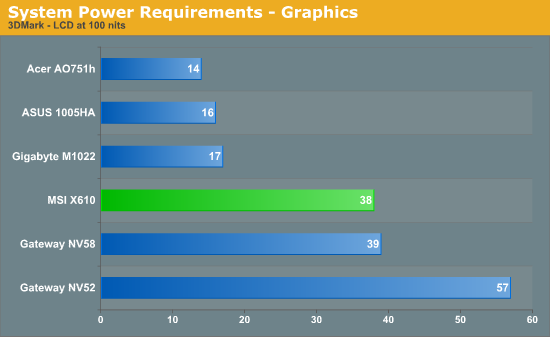
If you thought that perhaps the Neo MV-40 CPU wasn't doing a good job at saving power, at least relative to the QL-64 it clearly has a lower worst-case power requirement. It's all of the other equipment in the MSI X610 that consumes power, with idle power draw of 22W easily eclipsing the NV52's 14W. Place a significant load on just the CPU, however, and the X610 only increases its power draw by 11W whereas the NV52 jumps up 21W. Yes, the single-core AMD CPU is capable of using relatively little power. Unfortunately, it appears that the HD 4330 graphics chip is using at least 10W when idle, and 15~20W under load. The result is that the less power hungry CPU combined with a discrete GPU isn't a great low-power solution.










41 Comments
View All Comments
AnnonymousCoward - Wednesday, October 7, 2009 - link
1366x768 sucks.You can get a Dell 15.6" 1600x900, dual core pentium T4200, 6-cell battery, with DVD drive for $514. Or with the HD4330 for $614. The X610 is $735. The Dell weighs 1.5 pounds more, though, so you'll need to hit the gym.
Mint - Wednesday, October 7, 2009 - link
That's a pretty big "though". 4.5 lbs is just about the limit for fairly comfortable portability, and comparing it to a 6 lb notebook is ludicrous.1366x768 on a 15.6" is similar pixel size to most desktop monitors, and 1440x900 isn't that much better yet it's the highest resolution you get in a 4.5 lb notebook, AFAIK. Compare it with the top rated notebooks at this weight, like the Timeline 4810 (same res) and MacBook Pro 13" (1280x800).
AnnonymousCoward - Wednesday, October 7, 2009 - link
Comparing 4.5 pounds to 6 pounds is ludicrous? If you're that picky about weight, you'd better go for a 2 pound netbook. I would gladly take the 1.5 pounds for the high res screen and fast CPU.gstrickler - Wednesday, October 7, 2009 - link
Actually, Dell lists it at 5.54 pounds with 6 cell battery and DVD drive. It's under 6 pounds no matter how you configure it. Yes, the extra pound will make a difference, but anything under 6 pounds is very portable.Certainly, the Dell Studio 15 sounds more interesting than the MSI X610, and I would like to see how a Dell Studio 15 and/or 13" MacBook compare in performance and battery life. The Dell has the Intel X4500HD IGP standard, offers HD4570 discrete GPU as an option. The MacBooks uses the Nvidia 9400M G chipset. Both IGPs are slower than the HD4330, but they're not terrible and they use a lot less power. Both use C2D (the Dell base price has the dual core Pentium T4200, which is a C2D with less cache and slower FSB, but that's still a big step up from a single core 1.6GHz Athlon).
Mint - Thursday, October 8, 2009 - link
The market has proven both of you wrong for many years now. Why do you think Vaios and Lifebooks cost so much? Or why Apple charges more for the Air than the Pro 13"? Why do you think the M1330 was such a hit, despite costing much more than 15" Dells? Why do you think the X60/X200/X300 Thinkpads sell for so much more than 15" Thinkpads?5 lbs really is where it starts getting uncomfortable for the majority of people. 4 lbs is nice, 3 lbs is desireable. Netbooks took off when they weren't any cheaper than much faster value notebooks.
sxr7171 - Friday, October 9, 2009 - link
Ha Ha, that's what I was thinking the whole time reading this article. I'm sitting here with a 2.4lb Thinkpad X200s laughing in my head wondering about in what parallel universe would a 4.5lb laptop be considered light.This thing weighs 2.4lbs and packs a Core 2 Duo. There is no way they will allow these "netbooks" to cannibalize the sales of ultraportables hence the awkward netbook form factors as this machine. The only netbook that could even tempt me is the 1.4lb Vaio-P or actually now the Vaio-X. There could not possibly be a better machine made for surfing the internet while lying on the couch.
Also that Dell E4200 - great specs, nice 2.2lb weight.
Mint - Saturday, October 10, 2009 - link
If you're laughing at me, then what do you think about the guys that I replied to who are suggesting a 6lb notebook is light enough and comparable to this?Regardless of screen size, you can rarely get more than 1366x768 in a 4.5lb notebook for less than twice the price. No Apples, only two Dells (the 14z's), no IdeaPads (Thinkpads are way too expensive), etc.
AnnonymousCoward - Thursday, October 8, 2009 - link
I don't really understand your last sentence. I think netbooks took off since they were dirt cheap and ultra portable.Weight-aside, at 15.6", 1600x900 is a must.
Bull Dog - Wednesday, October 7, 2009 - link
I recently owned a MSI GT735 laptop and it too had the integrated GPU disabled. On the other hand, my family has a couple of old Asus laptops with 2.0GHz Turion 64 X2 CPUs and Mobility Radeon 2600 GPUs and x1250 integrated graphics and Asus gave users to option in the bios to switch between the two. And this was long before AMD was talking about doing this.Additionally the 1366x768 LCD screens are just fail. 800 vertical pixels is bad enough, now I'm supposed to step down to 768? No thank you. Why didn't MSI include AMD's dual core Athlon x2 Neo cpu instead? Probably cost reasons but it would have made the laptop far more convincing. Personally, I'm loving my HP dvz2.
dingetje - Wednesday, October 7, 2009 - link
"If MSI could keep the price close to $500 (€500)"eh, 500 Euro is about 735 US Dollar ... oops?